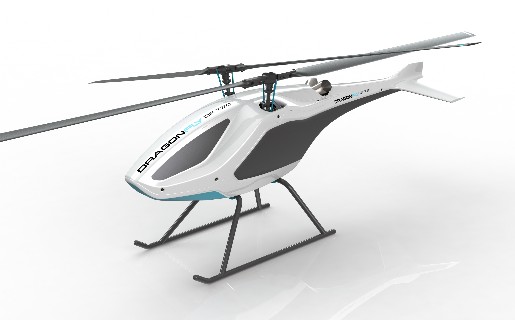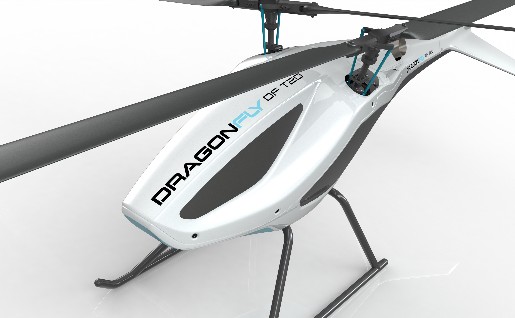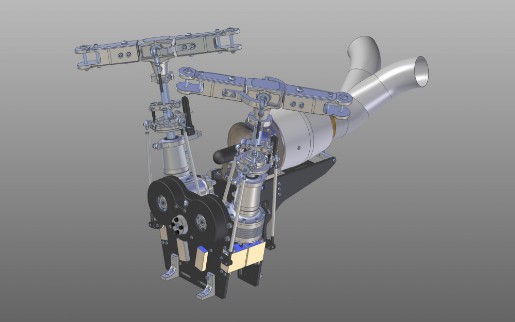Helicopter > Helicopter with Flettner double rotor
Dragonfly T20-RC
Dragonfly T20-RC
From autumn 2025 we will be offering the Dragonfly T20-RC helicopter with the Flettner double rotor system.
The helicopter is an elegant, functional model with a rotor diameter of 2.45 m, suitable for our Flettner double rotor mechanics with turbine or electric motor.
Presentation of the new Dragonfly T20-RC at the Jetpower 2025 exhibition. Shown here in a custom paint scheme. Mounted is a Jakadofsky PRO-6000.


Kit Dragonfly T20-RC
- Flettner-Mechanics, prepared for turbine PRO-6000: 3.995,- Eur
- alternatively: elektro Flettner mechanics, prepared for Hacker Q80: 3.995,- Eur
- fuselage Dragonfly T20-RC (4-parts, white top layer), kit, including frame set: 2.495,- Eur
- tank, Kevlar, 3,5 Ltr.: 285,- Eur
- exhaust system for turbine PRO-6000, stainless steel: 425,- Eur
- landing gear (welded aluminum), including chassis cross members (aluminum): 675,- Eur
- Microprocessor mixer electronics for controlling the two swash plates in the model (required to operate the model): 380,- EUR
- Kit without turbine, RC electronics, rotor blades
On request we can offer you the following components to complete the helicopter:
- Aluminum rotor blades 2.45 m, Viper-X76
- alternatively: rotor blades 2.45 m, carbon
- complete RC electronics
- Jakadofsky turbine PJW PRO-6000 or alternatively: Hacker Q80 with controller and akkus
- painting of the model
- on request we will offer conversion kits to adapt the other Flettner-mechanical types from our program (here the raised turbine)
- complete assembly of the kit, the RC-electronics and the turbine. On request up to the ready-to-fly model
From the beginning of spring 2026, the newly introduced tectronic-in-motion flight controller will also be available, for easier and safer flight operation of large RC-model helicopters.
Technical datas Dragonfly T20-RC
- rotor diameter: 2.45 m
- rotor angle: between the two rotor axes 24°
- overall length: 250 cm
- body length: 190 cm
- body width: 40 cm
- width over the landing gear: 50 cm
- width over the tailplanes: 51 cm
- body height: 42 cm
- height above all: 78 cm
- engine: Jakadofsky PJW-Turbine PRO 6000 (alternatively: electrically by Hacker Q80)
- tank: Kevlar, ca. 3.5 ltr.
- mechanics: robust industrial standard, completely in precision CNC aluminum production and carbon
- rotor head: 2 pcs. 2-blade rotor heads, completely in aluminium, blade bearing shaft 12 mm diameter, blade handles 22 mm
- power transmission: 3-stage reduction gear, last gear stage running in an oil bath
- rotor head speed: 900 rpm
- swashplate control: 6 x servos KST X20-3612 for the 3-point linkage of the two swashplates, other servos on request)
- FBL system: all commercially available 3-axis stabilization systems can be integrated (e.g. Bavarian Demon 3X, Beast-X)
- fuel: kerosene/oil mixture (5% oil content)
- take-off weight: approx. 20 kg
- mixer: electronic swashplate mixer
- mixing functions: Control of the two swashplates (120° mixer) for the pitch, pitch, roll and yaw functions
Decription ot the Flettner mechanics Dragonfly T20-RC
The complex mechanics of the model helicopter were developed entirely using 3D software. This is the only way to achieve the greatest possible planning security right from the start. All components are then manufactured based on the derived drawings and fit and function as planned right from the start.
About the drive: the PJW turbine "PRO 6000" located behind the mechanics transfers the power to the two main rotors via a 3-stage gearbox. The two rotors are coupled to each other via the middle pair of gears and are decoupled from the drive via a freewheel during autorotation.
In addition to the PJW turbines from Jakadofsky, the Q80 from Hacker is planned as an electric version.
The PJW turbine sits above the Delrin gear, the first gear stage to keep the exhaust pipe as short as possible.
As usual, the entire mechanism is precision CNC-manufactured (aluminium 7076-T6, all parts are black anodized). Carbon components complete the mechanics
Technical description:
- counter-rotating, intermeshing 2-blade double rotor system based on the Flettner principle
- very compact mechanics
- all CNC parts are made of aerospace aluminum (EN AW-7075 T6, black anodized) and carbon
- 3-stage reduction gear (or 2-stage with electromechanics), last stage running in an oil bath (completely encapsulated)
- linkage of the two swashplates via 3 servos each, free of play 120° linkage
- all ball heads on the two swash plates and rotor heads are made of steel
- more than 40 bearings installed
- rotor shaft diameter 15 mm
- swashplate driver with full ball bearings
- blade bearing shaft diameter 12 mm
- rotor blade connection dimension 22 mm, 6 mm bore
- industrial quality finish
- detailed assembly and adjustment instructions
- assembly kit, assemblies that are difficult to assemble are supplied pre-assembled

View of the mechanics with the Jakadofsky PRO-6000 turbine, including the special exhaust pipe. The turbine is positioned higher here to ensure the shortest possible exhaust system
Some views of the Dragonfly T20-RC
Elektronic mixer for the Dragonfly T20-RC
A special mixer electronics is required to control the two swash plates, which we also offer as an accessory. This electronics is connected in the model between the receiver and the swash plate servos. The advantages of such electronics are that important parameters can be changed quickly by changing the software. An associated programming module can be connected to the electronics in the model via a network cable. This can then be used to adjust all parameters in the workshop or on the airfield.
The model helicopter can be controlled like any other helicopter. Any normal remote control transmitter can be used as a transmitter without special mixers on the transmitter side.
A 3-axis flybarless system can also be easily integrated, see below.
The following functions are supported by the mixer electronics:
Processing of the signals for collectiv, roll, pitch and yaw from the receiver to control the two swashplates with 3 high-performance servos per swashplate, i.e. a total of 6 servos to control the two swashplates.
A stabilization system (e.g. Heli Command, V-Stabi, Beast-X etc.) or individual gyro systems (e.g. GY-401) for individual axes can also be looped in between the receiver outputs and the mixer electronics.
Alternatively, a Pixhawk 4 can also be used in the future. The special programming required to control the two swashplates is in preparation
Reprint only with permission of the author. All statements without guarantee.